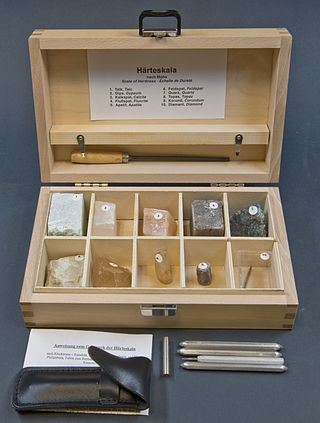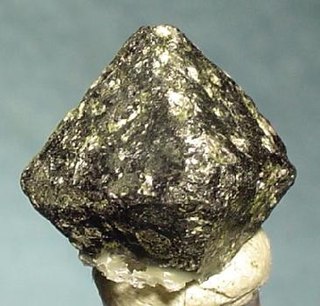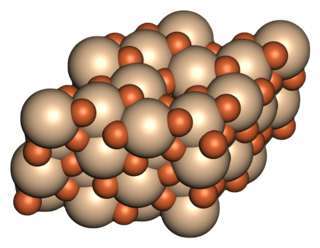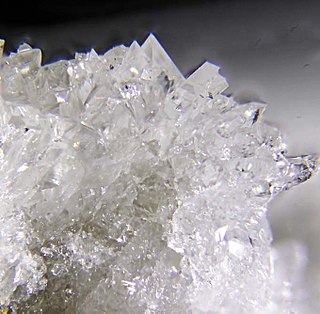
Mineralogy is a subject of geology specializing in the scientific study of the chemistry, crystal structure, and physical properties of minerals and mineralized artifacts. Specific studies within mineralogy include the processes of mineral origin and formation, classification of minerals, their geographical distribution, as well as their utilization.

The Mohs scale of mineral hardness is a qualitative ordinal scale, from 1 to 10, characterizing scratch resistance of minerals through the ability of harder material to scratch softer material.

Hibonite is a mineral with the chemical formula (Ca,Ce)(Al,Ti,Mg)12O19, occurring in various colours, with a hardness of 7.5–8.0 and a hexagonal crystal structure. It is rare, but is found in high-grade metamorphic rocks on Madagascar. Some presolar grains in primitive meteorites consist of hibonite. Hibonite also is a common mineral in the Ca-Al-rich inclusions found in some chondritic meteorites. Hibonite is closely related to hibonite-Fe ) an alteration mineral from the Allende meteorite. Hibonites were among the first minerals to form as the disk of gas and dust swirling around the young sun cooled.

Chromite is a crystalline mineral composed primarily of iron(II) oxide and chromium(III) oxide compounds. It can be represented by the chemical formula of FeCr2O4. It is an oxide mineral belonging to the spinel group. The element magnesium can substitute for iron in variable amounts as it forms a solid solution with magnesiochromite (MgCr2O4). A substitution of the element aluminium can also occur, leading to hercynite (FeAl2O4). Chromite today is mined particularly to make stainless steel through the production of ferrochrome (FeCr), which is an iron-chromium alloy.

Xifengite (Fe5Si3) is a rare metallic iron silicide mineral. The crystal system of xifengite is hexagonal. It has a specific gravity of 6.45 and a Mohs hardness of 5.5. It occurs as steel gray inclusions within other meteorite derived nickel iron mineral phases.

Lulzacite is a strontium-containing phosphate mineral with the chemical formula Sr2Fe2+(Fe2+,Mg)2Al4(PO4)4(OH)10.

Amicite is a silicate mineral of the zeolite family. It has a general formula of K2Na2Al4Si4O16·5(H2O). Amicite was described in 1979 from specimens obtained at the Höwenegg quarry in Immendingen, Hegau, in the German state of Baden-Württemberg, which is consequently its type locality. The name is in honor of Giovanni Battista Amici (1786–1863) a botanist, physicist, optician, and inventor of microscope optical elements.

Switzerite is a mineral with the chemical formula of (Mn)3(PO4)2·7H2O. The mineral was named after George Switzer, former Curator of Minerals at the US National Museum.The mineral is monoclinic prismatic, meaning that it has one mirror plane, one 2-fold rotation axis which is perpendicular to the mirror plane and a center of symmetry. Switzerite is a part of the monoclinic space group P 21/a. For its optical properties, Switzerite is classified as anisotropic, has a low surface relief and birefringence of δ = 0.020.

Kanoite is a light pinkish brown silicate mineral that is found in metamorphic rocks. It is an inosilicate and has a chemical formula of (Mg,Mn2+)2Si2O6. It is a member of pyroxene group and clinopyroxene subgroup.
Sweetite has a general formula of Zn(OH)2. The name is given after a curator of mineral department of The British Museum, Jessie May Sweet (1901–1979). It occurs in an oxidized vein in limestone bedrock with galena, ashoverite, wülfingite, anglesite, cerussite, hydrocerussite, litharge, fluorite, palygorskite and calcite.
The Hatrurim Formation or Mottled Zone is a geologic formation with outcrops all around the Dead Sea Basin: in the Negev Desert in Israel, in the Judaean Desert on the West Bank, and in western Jordan. It includes late Cretaceous to Eocene aged impure limestone along with coal bearing chalk and marl. The rocks have been subjected to pyrometamorphism resulting from combustion of contained or underlying coal or hydrocarbon deposits. The formation is named for exposures in the Hatrurim Basin which lies west of the Dead Sea.

Daubréelite is a rare sulfide mineral. It crystallizes with cubic symmetry and has chemical composition of Fe2+Cr3+2S4. It usually occurs as black platy aggregates.

Djerfisherite is an alkali copper–iron sulfide mineral and a member of the djerfisherite group.

Shulamit Gross was an Israeli mineralogist and geologist who studied the Hatrurim Formation.
Jodzie is a meteorite that fell on 17 June 1877 near the village of Juodžiai near Panevėžys. It is a relatively rare howardite with some carbonaceous inclusions that were likely a result of an asteroid collision. Therefore, despite its small size, it has been a subject of several scientific studies.
The sulfate chlorides are double salts containing both sulfate (SO42–) and chloride (Cl–) anions. They are distinct from the chlorosulfates, which have a chlorine atom attached to the sulfur as the ClSO3− anion.

The sulfate carbonates are a compound carbonates, or mixed anion compounds that contain sulfate and carbonate ions. Sulfate carbonate minerals are in the 7.DG and 5.BF Nickel-Strunz groupings.
Krinovite is an emerald-green triclinic meteorite mineral, containing chromium, magnesium, oxygen, silicon, and sodium, of the aenigmatite group. "It has been discovered within graphite nodules in three iron meteorites," specifically the Canyon Diablo, Wichita County, and Youndegin meteorites. It was named in honour of Evgeny Leonidovich Krinov, Russian investigator of meteorites. It is a decaoxotrisilicate in the sorosilicate subclass.

Xiaogang Ma or Marshall Ma is a Chinese data science and geoinformatics researcher at the University of Idaho (UI), United States. He is an associate professor in the department of computer science at UI, and also affiliates with the department of earth and spatial sciences and several research institutes and centers at the university.














